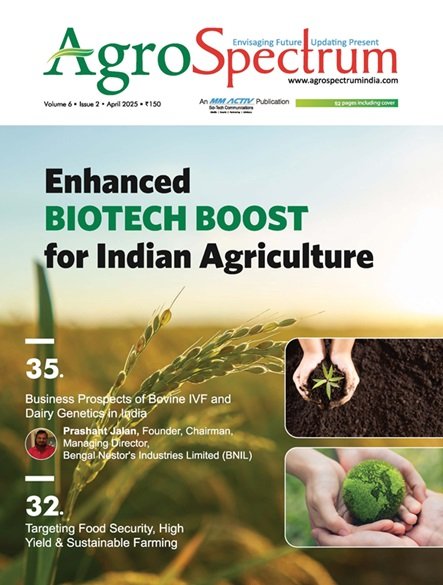Wednesday, 12 November 2025

Let’s examine how crucial biotechnology is for another agri boom.
The uses of biotechnology in agriculture are extensive and profound, ranging from crop improvement to soil health, pest and disease control, and sustainable agricultural methods. A potent weapon, so to speak, in the arsenal of agricultural biotechnology is genetic engineering, which makes it easier to modify plant genomes to impart desired characteristics, including higher yield, improved nutritional value, and tolerance to biotic and abiotic challenges. This strategy is complemented by molecular breeding techniques, which use genomics and bioinformatics advancements to speed up the breeding process and create high-performing crop varieties suited to particular agroecological contexts. Let’s examine how crucial biotechnology is for another agri boom.
An unwavering dedication to developing India’s biotechnology industry is evident in the Union Budget 2025. Budget 2025 has increased funding for biotechnology to promote biomanufacturing, biotech research, entrepreneurship, innovation, and skill development, among other things. With the government’s commitment to Aatmanirbharta in edible oils and pulses, the “National Mission on High Yielding Seeds,” and the “Mission for Cotton Productivity,” Nirmala Sitharaman has placed a strong emphasis on agriculture as the primary engine of growth.
The execution of mission programmes on minor oil seeds, such as linseed, sesame, niger, and safflower, has been assigned to the Department of Biotechnology, Government of India, with the intent to accelerate genetic improvement, increase production, and promote sustainability. Along with exotic lines from various agroclimatic areas and elite lines of international institutes, the Department is also assisting with the genotypic and phenotypic characterisation of the nation’s existing germplasm resources of pulses, such as chickpeas.
The Amaranth Genomic Resource Database, an integrated database resource of Amaranth genes and genomics for quick screening of oil, protein, fatty acids, and essential amino acids in amaranth grain, is a significant advancement in Indian biotechnology. Golden Rice represents a breakthrough in agricultural biotechnology, offering a potential solution to the widespread problem of vitamin A deficiency. While progress has been made in India and globally, its adoption has been slow due to regulatory challenges, public opposition, and political debates about GM crops. In India, Golden Rice is moving closer to commercialisation, with recent regulatory approvals and successful trials paving the way for future adoption. Globally, countries such as the Philippines and Bangladesh are leading the way in the approval and potential distribution of Golden Rice.
The discovery of a new pathogen, Fusarium proliferatum, which causes safflower wilt in Karnataka and Maharashtra fields, has allayed worries about safflower wilt caused by Fusarium oxysporum. A paradigm change has occurred in the technology landscape for understanding plant biology and bio-engineering technologies. By substantially improving input use efficiency while developing smart sensor plants, emerging technologies such as precise engineering tools, nanosensors, automation, machine learning, and artificial intelligence-assisted data integration have the potential to revolutionise and sustainably alter Indian agriculture. In recognition of the potential of genome editing technology for the agricultural sector, the Indian government exempted SDN1 and SDN2 categories from biosafety regulations under Rule 20 of Rules 1989 of the EPA 1989. This paved the way for the development of new indigenous tools (vectors, nucleases, etc.), methods, and regeneration protocols for recalcitrant crops, as well as the deployment of trait-specific candidate gene(s) with established proof-of-concept into elite commercial cultivars and varieties.
The Indian government earlier announced 109 high-yielding, climate-resilient, and biofortified varieties of 61 crops in 2024, including 34 field crops and 27 horticultural crops. Nine rice varieties, six maize variations, two wheat varieties, one each of jowar, bajra and ragi, seven different oilseed varieties, eleven pulse varieties, five cotton varieties, and four sugarcane varieties are among the new crop varieties created by ICAR scientists. Among other fruits, vegetables, and medicinal plants, the new horticulture crop varieties include three mangos, two guavas, one pomegranate, and two tomatoes. These crop varieties were created for the country’s distinct agroclimatic zones, emphasising short duration, drought and flood resilience, and adaptation to a range of biotic and abiotic factors. Records from the ICAR indicate that 2,593 high-yielding cultivars were released between 2014–15 and 2023–24. These include 150 biofortified varieties and 2,177 climate-resilient cultivars (83 per cent of the total) that are resistant to biotic and abiotic stress. Among the most successful varieties created by the institute are high-yielding, fine-grained, aromatic Basmati rice (Pusa Basmati 1121, Pusa Basmati 1509, Pusa Basmati 1401, and Pusa Basmati 17180), which contribute to an annual export of over Rs. 42,000 crores. The newly launched BioE3 Policy is anticipated to stimulate high-performance biomanufacturing for environmentally friendly, sustainable growth. BioE3 shall catalyse the roadmap on how India may create bio-based solutions to maintain agricultural production systems in the face of climate change by utilising its enormous reservoir of bioresources, chalking out ways to scale up manufacturing capabilities, the use cutting-edge technologies like synthetic biology to improve microbial chassis for novel bioprotectants, biostimulants, and biofertilisers to sustain plant yields, and implement domestic solutions for increasing plant productivity through microbial and plant systems.
To read more click on :https://agrospectrumindia.com/e-magazine